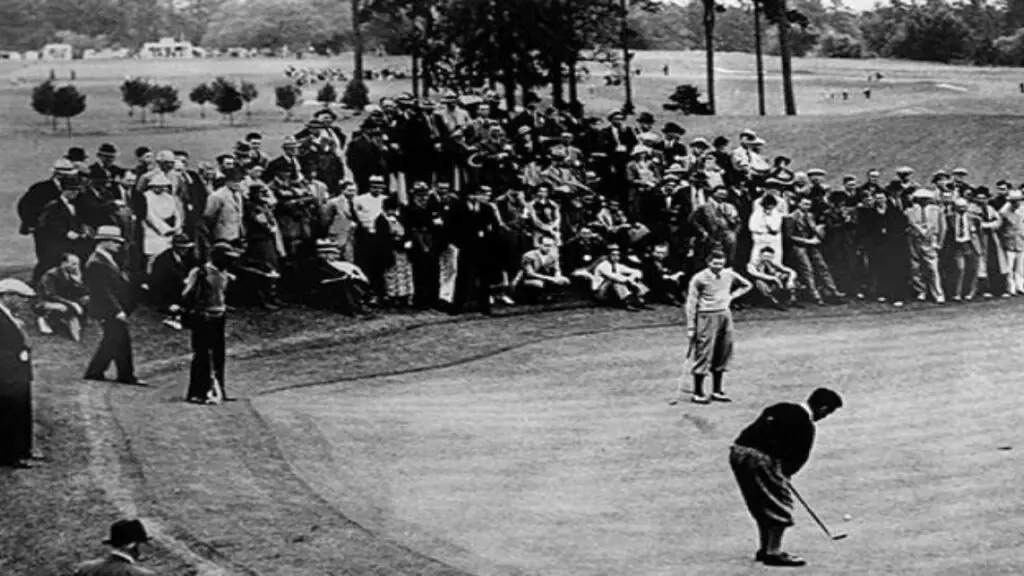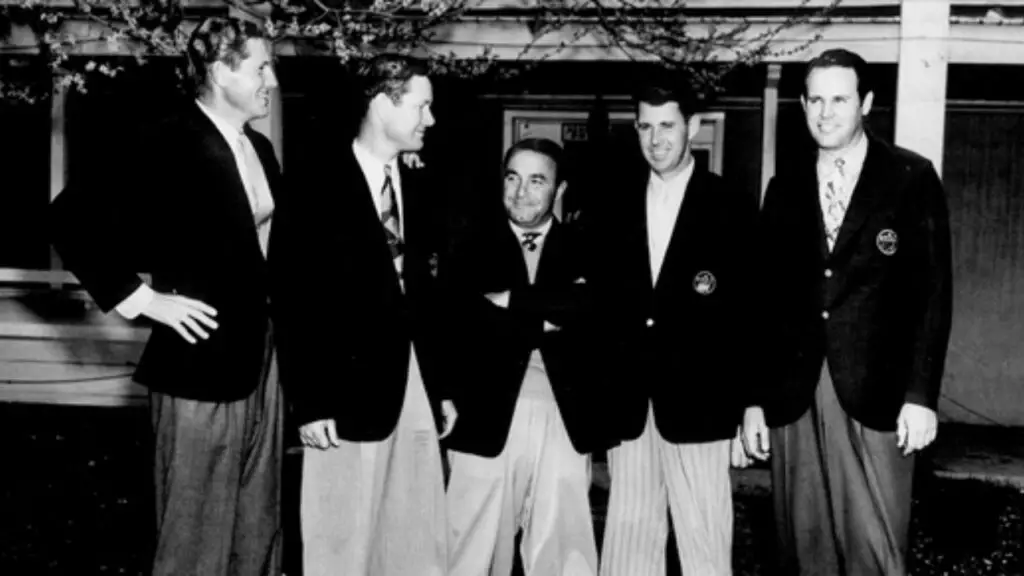
Step into the hallowed halls of golf’s most prestigious event – The Masters Tournament. Immerse yourself in a rich history dating back to 1934, where legendary champions have etched their names in the game’s annals. From the lush greens of Augusta National Golf Club to the coveted green jacket, experience the unique traditions and unparalleled format that sets The Masters apart as the ultimate test of golfing excellence. Join us as we unveil the storied past and present of The Masters Tournament.
Overview

The Masters Tournament began in 1934 as the brainchild of two men: Bobby Jones, a legendary golfer who won 13 major championships, and Clifford Roberts, a successful investment banker. Jones, who was nearing the end of his competitive golf career, wanted to create a tournament featuring the best golfers from around the world and be held on a course that he and his friend, Alister MacKenzie, had designed called Augusta National Golf Club.
Roberts, who would become the Chairman of Augusta National, shared Jones’s vision, and together, they decided to create an invitation-only tournament that would be held annually at Augusta National. The tournament was initially called the Augusta National Invitation Tournament and was intended to be a replacement for the Atlanta-based Southeastern Open, which had been struggling financially.
The tournament’s first edition was held on March 22-25, 1934, a field of 30 players was invited, and the game had a 36-hole qualification round to determine the final field, which was then reduced to the low 16 scores for the match play tournament. Horton Smith was the first winner, and he defeated Craig Wood 1-up in the final match.
Over the years, the tournament has grown in prestige and popularity. It became one of the major championships in the sport and is now considered one of the most highly-anticipated and prestigious events in professional golf. The tournament has also established many traditions, such as the green jacket, awarded to the winner and must be returned to Augusta National the following year, and the par-3 contest held on the Wednesday before the tournament.
Augusta National Golf Club
Augusta National Golf Club is the home of The Masters Tournament, one of the four major championships in professional golf. The club was founded in 1933 by Bobby Jones and Clifford Roberts, two golf enthusiasts who envisioned creating a course that would challenge the best golfers in the world. Jones, a legendary golfer having won 13 major championships, played a significant role in designing the course with course architect Alister MacKenzie.
The club opened in 1933, and the first Masters Tournament was held in 1934. Since then, the tournament has been held annually at Augusta National, except for 1943-1945, when the game was suspended due to World War II. Throughout its history, Augusta National has undergone several changes and renovations, intending to maintain the integrity and challenge of the course.
The Augusta National course is considered one of the most iconic and challenging in the world, with its picturesque setting, well-manicured fairways, and fast greens. The course features many challenging holes, including the famous Amen Corner, which includes holes 11, 12, and 13. The tournament’s final round is played on the last nine holes of the course, which consists of the famous par-3 12th hole, known as the “Golden Bell.”
The club’s relationship to The Masters Tournament has been an important one, as the tournament has become a part of the club’s identity, and vice versa. The tournament is one of the most significant events on the golfing calendar, and Augusta National Golf Club is considered one of the most storied venues in the sport.
Traditions
The Masters Tournament is known for its rich history and many traditions, which have become integral to the tournament’s identity. Some of the most notable traditions of The Masters include:
- The Green Jacket: One of the most iconic traditions of The Masters is the Green Jacket, awarded to the tournament winner. The winner receives a special Masters Green Jacket, which is designed and made specifically for the tournament and must be returned to Augusta National the following year. The Green Jacket is a symbol of The Masters and its prestige and is considered one of the most coveted awards in golf.
- The Par-3 Contest: Held on Wednesday before the tournament begins, the par-3 contest is a lighthearted and relaxed event where golfers compete on the par-3 course at Augusta National. The contest is a popular event among fans and golfers and is often considered a good luck charm, as no one who has won the par-3 contest has ever won The Masters in the same year.
- The Ceremonial Tee Shots: On the Thursday morning of tournament week, two honorary starters hit the opening tee shots to begin the tournament. These starters are typically golfing legends who have made significant contributions to the game and the tournament.
- The Amen Corner: This section of the course, which consists of holes 11, 12, and 13, is considered one of the most challenging and iconic parts of the Augusta National course. The section got its name from a 1958 Sports Illustrated article by Herbert Warren Wind and is considered one of the most iconic places in golf.
- The Butler Cabin: After the final round, the winner is presented with the green jacket in the Butler Cabin, a small building located near the 18th green. The winner will then give an interview with CBS broadcaster Jim Nantz and makes a few remarks.
- Champions Dinner: The Masters winner gets to host the Champions Dinner the next year. It is a special gathering of the past champions of The Masters. The winner chooses the menu for the dinner which traditionally is his favorite food.
- The Masters Flag: The Masters Flag is a replica of the tournament logo, and is flown over the clubhouse throughout the tournament. It is also used as a symbol of The Masters, and is featured on various merchandise and memorabilia.
- The Scoreboard: The Masters scoreboard is one of the most recognizable and iconic elements of the tournament. It is prominently displayed near the 18th green and provides a real-time update of the leaderboard throughout the tournament.
- The Masters Flagstick: The flagstick at The Masters is made from hickory wood, which is a nod to the early days of golf when hickory shafted clubs were used.
- The Masters invitation: The Masters invitations are considered among the most prestigious in sports and are hand-delivered to the invitees.
- The Magnolia Lane: Magnolia Lane is the tree-lined driveway that leads to the Augusta National Clubhouse. The Lane is lined with magnolia trees, which were planted in the 1930s when the club was founded. The drive is also a popular place for fans to gather and take pictures.
- Music: During the tournament, Augusta National plays classical music over loudspeakers, which is mostly organ based. and it is the same playlist since the tournament began.
- The Masters Journal: The Masters Journal is an official publication of the tournament that is distributed during the tournament week. It features stories, photos, and statistics about the tournament and its history.
These traditions and many others have become an integral part of The Masters experience, making it one of the most iconic and prestigious events in golf. The tournament’s traditions and rituals are a testament to its rich history and prestige and are an important part of what makes The Masters so special.
Awards
Where glory and greatness meet – The Masters Tournament awards”
The Masters Tournament is one of the most prestigious and highly-anticipated events in professional golf, and winning the tournament is considered a major achievement in a golfer’s career. The tournament awards several accolades and prizes to the players, including:
The Green Jacket: The green jacket is the most iconic award of The Masters Tournament, and it is awarded to the winner of the tournament. The winner of The Masters will receive a special green jacket, which is designed and made specifically for the tournament, and must be returned to Augusta National the following year. The jacket is made of wool and has a traditional, single-breasted design, with a two-button front and a notched lapel.
The jacket is tailored to fit the winner and features the Augusta National logo on the breast pocket and the winner’s name, and the year they won the tournament on the inside pocket. The green jacket is considered a symbol of The Masters and its prestige and is considered one of the most coveted awards in golf.
The tradition of the green jacket began in 1949 when Sam Snead was awarded the first green jacket. The idea for the green jacket came from the founders of the club, Bobby Jones and Clifford Roberts, who wanted to create a way for members of the club to easily identify one another. The green jacket quickly became an iconic symbol of The Masters, and it has become one of the most recognizable awards in all of the sports.
The winner of The Masters gets to keep the jacket for a year and is expected to wear it during the tournament’s Champions dinner and during other events hosted by the Augusta National. After the year is over, the winner must return the jacket back to the club and is given a replica of the jacket to keep.
The Silver Cup: The Silver Cup is the tournament’s official trophy, and it is awarded to the winner of The Masters. The cup is made of silver and is engraved with the winner’s name, the year they won, and their score. The cup stands around 2 feet in height and has handles on each side of the bowl. It was designed by the co-founder of Augusta National Golf Club, Clifford Roberts, with the help of a New York-based company called Shreve, Crump & Low.
The cup was first awarded in 1949, and it has been awarded to the winner of The Masters every year since. Winning the Silver Cup is a significant achievement in a golfer’s career, and it signifies their status as a Masters champion. The cup is a cherished keepsake, and it is a reminder of the golfer’s victory at Augusta National.
The cup will be kept by the winner for the next year, before it’s returned to Augusta National and they are given a replica of the cup to keep. The Silver Cup, along with the Green Jacket, is one of the most iconic awards of The Masters Tournament. The winner of The Masters has his name inscribed on the cup and it is considered a rare and precious record of one’s golfing achievements.
The Silver Cup, and the other awards associated with the tournament, are a testament to the prestige and history of The Masters and make it one of the most coveted titles in the sport of golf.
Prize Money: The Masters Tournament awards significant prize money to the players, with the winner of the tournament taking home the largest share. Prize money for the tournament has grown significantly over the years, reflecting the growing popularity and prestige of the event.
In 2021, the winner of The Masters received $2.07 million, and all other players who made the cut also received prize money, with the amount decreasing as the players’ finishing position got worse.
The player who finishes second will receive $1,242,000 and the player who finishes third will receive $784,000 and so on. Prize money for non-winners increases in an incremental way, up to the 30th position, which is awarded $63,000.
Prize money is an important aspect of professional golf, and it is a significant incentive for players to compete at the highest level. The Masters Tournament’s prize money is among the highest in the sport, reflecting its prestige and status as one of the four major championships in professional golf.
Lifetime Exemption: In addition to the prize money, lifetime exemption is a notable award given to the winner of The Masters Tournament. It is a special privilege that allows the winner to compete in the tournament for the rest of their lives, without having to qualify. This means that the winner can automatically enter the tournament each year as long as they are able to compete and wish to do so.
The lifetime exemption was first given out in 1949 and since then, many notable players have won The Masters, which has helped to establish the tournament as one of the most prestigious and iconic events in the sport. This tradition of lifetime exemption has been continued by Augusta National to this day and it still holds true that The Masters champions are given the privilege of participating in the tournament for the rest of their lives.
The Masters is considered one of the four major championships in professional golf, and winning The Masters is considered a major achievement in a golfer’s career. The lifetime exemption is a prestigious award that honors the winner’s achievement and solidifies their place in Masters history.
The Masters Medal: All players who compete in The Masters receive a Masters Medal, which is a commemorative medal that features The Masters logo and the year of the tournament.
The Low Amateur: The Masters Tournament also awards a special prize to the low amateur of the tournament. The low amateur is defined as the amateur golfer who scores the lowest total score over the tournament. The award is given to the amateur golfer who has the lowest score among the amateurs who make the cut and are in the tournament on the weekend.
The winner of the low amateur award is presented with a Silver Cup and also receives an invitation to the next year’s Masters. This award is significant as it provides an opportunity for amateur golfers to compete against the best professional golfers in the world and also earns an invitation to play in The Masters again.
The award has been given out since 1957, and has been won by many notable amateur golfers over the years, including Jack Nicklaus, Phil Mickelson and Tiger Woods. This award has also helped launch the careers of many amateur golfers, as it provides them with an opportunity to compete against the best professional golfers in the world, and also earn an invitation to play in The Masters again.
The Hole-in-One award: The Hole-in-One award is a special award given at The Masters Tournament for a golfer who scores a hole-in-one on the par-3 16th hole during the tournament. This hole-in-one is considered a rare and impressive achievement and it’s also considered an iconic hole at Augusta National Golf Club.
The award for a hole-in-one on the 16th hole is a crystal bowl, presented by Augusta National Golf Club. It is an exclusive award, and not all the players get the opportunity to score a hole-in-one at The Masters, it’s a rare occasion and many players are unable to achieve it during the tournament.
Throughout Masters history, there have been many memorable shots made on the 16th hole including many Hole-in-One moments. Some notable players who have scored a hole-in-one on the 16th hole include Gene Sarazen, Jeff Sluman, and Fred Couples. These shots are considered iconic moments of the tournament and are remembered for a long time by fans and players alike.
These awards and accolades, along with the tournament’s prestige and history, make The Masters a coveted title for golfers around the world and winning it is considered a crowning achievement in a golfer’s career.
Pre-tournament events

The Masters Tournament is known for its rich history and many traditions, and the tournament week is filled with pre-tournament events that help create the unique atmosphere and experience of The Masters. These events include:
The Par-3 Contest: Held on Wednesday before the tournament begins, the par-3 contest is a lighthearted and relaxed event, where golfers compete on the par-3 course at Augusta National. The contest is a popular event among fans and golfers alike and is often considered a good luck charm, as no one who has won the par-3 contest has ever won The Masters in the same year.
The Champions Dinner: The Masters winner gets to host the Champions Dinner the next year. It is a special gathering of the past champions of The Masters. The winner chooses the menu for the dinner which traditionally is his favorite food.
The Masters press conference: Players who have qualified for the tournament are made available for a press conference on Tuesday before the tournament.
The pro-am: A pro-am tournament is held on the Wednesday before the tournament in which amateurs play with a professional golfer. The pro-am is one of the most popular events of the tournament week, and it is a chance for fans to see their favorite players up close and personal.
The Ceremonial Tee Shots: On the Thursday morning of tournament week, two honorary starters hit the opening tee shots to begin the tournament. These starters are typically golfing legends who have made significant contributions to the game and the tournament. The ceremonial tee shots are a special moment that officially opens the tournament, and it is often a nostalgic and emotional moment for fans, as well as for the honorary starters themselves.
The Masters practice round: Players have an opportunity to play the course for a practice round on Monday, Tuesday and Wednesday before the tournament begins. This allows players to familiarize themselves with the course, and make adjustments to their game plan.
These pre-tournament events, along with others, add to the unique atmosphere and experience of The Masters and help to create a special and memorable tournament week. They also give fans an opportunity to interact with the players, see them up close, and also experience the excitement of the tournament before it starts. All these events together make The Masters tournament one of the most iconic and prestigious events in golf.
Winners list
Since the tournament’s inception in 1934, The Masters has been won by many of the greatest players in the history of the game. Here are some of the notable winners of The Masters Tournament:
- Tiger Woods – Tiger Woods has won The Masters Tournament five times (1997, 2001, 2002, 2005, 2019) and is tied for the most wins in the tournament history with Jack Nicklaus.
- Jack Nicklaus – Jack Nicklaus has won The Masters Tournament six times (1963, 1965, 1966, 1972, 1975, 1986) and is tied for the most wins in the tournament history with Tiger Woods.
- Arnold Palmer – Arnold Palmer won The Masters Tournament four times (1958, 1960, 1962, 1964)
- Phil Mickelson – Phil Mickelson has won The Masters three times (2004, 2006, 2010).
- Sam Snead – Sam Snead won The Masters Tournament in 1949 and it was the first year the Green Jacket was awarded to the winner of the tournament.
- Jimmy Demaret – Jimmy Demaret was the first 3-time winner of The Masters in 1940, 1947, and 1950.
- Gary Player – Gary Player won The Masters Tournament three times (1961, 1974, 1978)
- Tom Watson, Bubba Watson, Charl Schwartzel, Sergio Garcia, Adam Scott, Danny Willet, Jordan Spieth and Dustin Johnson are among the other notable winners of The Masters Tournament.
These players are among the greatest golfers in the history of the game, and their victories at The Masters have helped establish the tournament as one of the most prestigious and iconic events in the sport. Winning The Masters is considered a crowning achievement in a golfer’s career, and a victory at Augusta National is a lasting legacy for any player.
Format
The tournament format is designed to test the skill and versatility of the world’s best golfers and consists of several stages:
Qualifying: The Masters is an invitational tournament, which means that the field of players is not determined by a qualifying tournament. Instead, the field is made up of a combination of past champions, top players from the Official World Golf Ranking, and a select number of amateurs who have achieved certain standards.
Practice rounds: On Monday, Tuesday, and Wednesday before the tournament begins, players have an opportunity to play the course for a practice round. This allows players to familiarize themselves with the course and make adjustments to their game plan.
Tournament Play: The tournament begins on Thursday and continues for four days, with 18 holes played each day. The tournament is a stroke play format, where the golfer with the lowest total number of strokes at the end of the tournament wins.
The Cut: After 36 holes, the field is cut to the top 50 players and ties. Those players who are not in the top 50 are eliminated and cannot continue to play in the tournament.
The Masters is a highly competitive tournament and one of the most sought-after titles in the game of golf. The challenging format, combined with the historical significance of the tournament, makes The Masters one of the most iconic and prestigious events in professional golf.
Course
The club is home to two 18-hole golf courses, the Tournament course and the Par-3 course.
The Tournament course is the course where The Masters is played. It is a challenging layout that measures 7,475 yards and has a par of 72. It features long fairways, strategic bunkers, and fast, undulating greens. It also boasts some notable holes, such as the par-3 12th hole, which is known as “Golden Bell” and the par-5 13th hole, known as “Azalea”, as well as the famous Amen corner, which includes the 11th, 12th and 13th holes.
The Par-3 course is also located on the Augusta National Golf Club and it is used for The Masters par-3 contest which is played on Wednesday before the tournament begins. The Par-3 course is a short, nine-hole layout that measures 1,060 yards and has a par of 27. The Par-3 course is not as challenging as the tournament course, but it’s a great venue for players and fans to enjoy a relaxed round of golf.
Most Wins
As of 2021, the most wins by a player in The Masters Tournament is six and achieved by Jack Nicklaus. He won the tournament in 1963, 1965, 1966, 1972, 1975, and 1986. The second-most wins by a player in The Masters is five, achieved by Tiger Woods in 1997, 2001, 2002, 2005, and 2019. In this tournament, the only players who won multiple times were Tiger Woods and Jack Nicklaus.
Records
Over the years, many records have been set and achieved at the tournament. Here are some notable records from The Masters Tournament:
- Most wins by a player: Jack Nicklaus and Tiger Woods both won The Masters Tournament six times.
- Lowest scoring total: The record for the lowest scoring total in The Masters Tournament is held by Tiger Woods, who shot 270 (-18) in 1997.
- Youngest winner: The record for the youngest winner of The Masters Tournament is held by Tiger Woods, who won the tournament at the age of 21 in 1997.
- Oldest winner: The record for the oldest winner of The Masters Tournament is held by Jack Nicklaus, who won the tournament at the age of 46 in 1986.
- Most Top-10 finishes: Jack Nicklaus holds the record for the most Top-10 finishes in The Masters Tournament with 20.
- Most consecutive cuts made: Gary Player holds the record for the most consecutive cuts made in The Masters Tournament with 23.
- Most consecutive Top-10 finishes: Jack Nicklaus holds the record for the most consecutive Top-10 finishes in The Masters Tournament with 8.
- Hole-in-one: The record for the most hole-in-ones in a single Masters Tournament is held by Jeff Sluman in 1992, with two.
These are some of the records in The Masters Tournament history. These records demonstrate the exceptional golfers and the moments that have occurred throughout the history of the tournament.
Broadcasting
The Masters Tournament is one of the most widely-watched and broadcast golf events in the world, and the tournament has a long history of television coverage dating back to the 1950s.
CBS has been the primary broadcaster of The Masters Tournament since 1956 and has exclusive rights to the event through 2032. CBS covers the tournament live on both television and streaming platforms, providing comprehensive coverage of the tournament throughout the week.
NBC also provide live coverage for some hours of the tournament; they have the rights to air the final round of The Masters since 1986
Alongside the live coverage, Masters.com provides live streaming of the tournament, including featured groups, Amen Corner, and holes 15 and 16. This enables golf fans around the world to keep up with the tournament, even if they are unable to watch it on television.
International broadcast partners such as Sky Sports and the BBC also provide live coverage of The Masters Tournament to viewers in their respective countries.
Ticketing
The Masters Tournament is one of the most sought-after tickets in the world of sports, and obtaining tickets to the tournament can be challenging. Here is an overview of the ticketing process for The Masters:
The Masters is an invitation-only event, which means that tickets are not sold to the general public.
Tickets are distributed through a variety of channels, including Augusta National Golf Club members, previous ticket holders, and corporate sponsors.
There is no public sale for Masters Tickets, so the only way for a person to attend the tournament is through the lottery system. Masters have a random selection process for ticket applications called The Masters Lottery, on which fans can apply for the chance to purchase tickets, usually this lottery opens around June of each year, and the results are announced a few months later.
Masters also offers an online ticket exchange program, and this program is operated by a third-party ticket reselling company, where tickets can be purchased from individuals who have obtained them through other means. But these tickets are often sold at a significant markup and not easily available,
The Masters also has a strict ticket policy, which states that all tickets are non-transferable and can only be used by the person named on the ticket, and that includes the practice round and the tournament days.
With the high demand and scarcity of The Masters tickets, the tournament often sells out quickly, and those who are fortunate enough to obtain tickets often hold onto them for years, making it a very exclusive event to attend.
The Masters Ticket process is designed to ensure that tickets are distributed fairly and that all fans have an opportunity to attend the tournament, but it can be difficult to get a ticket to The Masters due to the high demand and the limited number of tickets available.
Final thoughts
With a history that spans several decades, the tournament has become an integral part of the golfing calendar and a must-watch event for golf fans around the world. The tournament’s legacy and traditions make it one of the most distinctive events in the golf calendar, and it’s always an exciting and unmissable event for golf enthusiasts.
Reading about the history of The Masters Tournament provides a deeper understanding and appreciation for the tournament, and now that you have completed reading, you will be better equipped to enjoy and understand the tournament when it comes around each year.














